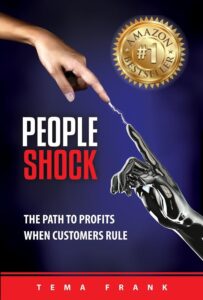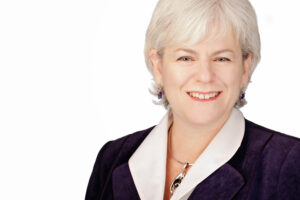The Decline of Customer Satisfaction
Customer satisfaction is going down, not up.
How can that be in a world with unprecedented technological progress?
Tema Frank founded Web Mystery Shoppers International, the world’s first company to test omnichannel customer service. Her new book, People Shock: The Path to Profits When Customers Rule , shows off both her decades of business experience and the research from interviewing over 150 business leaders. She developed a formula to help businesses improve the customer experience in the midst of a digitized world.
I recently asked her about her research.
What is PeopleShock?
As we automate more and artificial intelligence wipes out jobs, the smaller amount that is left for human to human interaction becomes critical. Companies that are people-focused (while using technology to support those people) are the ones that will win in an era of increasing competition and social media power. If you get the people side right, PeopleShock is your key to success. Ignore it and your company will soon be history.
Get the 3Ps of Profit Right
Please share your 3P Profit Formula with our audience.
Customers are cranky, and they’ve got more choices than ever before. So you’ve got to keep them happy, and that means getting all of the 3 Ps of Profit right:
Promise – Having a clear aspirational, inspirational and memorable reason for doing what you do inspires staff and customers. It also gives staff a filter for decision-making: Would their action be consistent with the company’s promise?
People – Business success comes from connecting effectively at a human level with people inside (staff) and outside your organization. Outsiders include not only prospects and customers, but people we sometimes overlook, like suppliers, distributors, lenders, investors, media and the public.
Process – As time goes by, some of the processes that got you to where you are stop making sense. To deliver consistently great customer experiences, you have to regularly re-assess how you’ve been doing things. Start by looking at processes from a customer point of view. What do they experience? Then look at how that lines up with what you do internally.
How does this translate into higher profits?
The book explains how each of the Ps leads to higher profits, but if we look at customer experience improvement overall, many studies show the ROI. In one, researchers at the University of Michigan found that if, in the year 2000, you had invested $100 in the overall US stock market (as represented by the S&P 500 index), by 2012 you’d be down to $93, or a loss of 7 percent. But if you had invested in a fund made up of companies that scored well on the American Customer Satisfaction Index over that same time, your $100 would have turned into $490, or an increase of 390 percent!
Use Promise to Guide Your Decisions
Promise. What is the role of promise in your equation? How has the promise element changed in this generation?
The biggest change in this generation is the pace of change. Technologies, competitors and market conditions change so fast that it is impossible to plan for everything that might happen and have an official response ready. And with social media, when a crisis hits, you can’t afford the time delays of going up through layers of authorization before reacting. So the promise gives you a filter that guides those spur-of-the-moment decisions and reactions. And it gives you a purpose so your staff and customers will care about what your organization does.
Let’s zero in on the people part of the equation. You talk about the hidden, unrecognized expense when people are showing up at work but are not actually working. What strategies do you recommend to reduce what you can “presenteeism”?
Honestly, the most important thing is to create an environment where employees care about the organization. If they care, they’ll want to do good work. That means you’ve got to have a promise they buy into. You must show them that you truly value their ideas as well as their work, and treat them as fully functioning adults, not as robots. If they come in at 9:10 instead of 9:00 a.m., does it really matter? The key is, are they getting the job done?
Break Down the Silos
I’m a big fan of silo slashing and love your take on it. Would you share an example of this in action?
There’s a company in Edmonton, Alberta, called Magnum Energy Services. One of their subsidiaries was struggling. The back office folks and those on the shop floor didn’t talk to or respect each other. Top management was seen as the enemy. And even on the production line, there was a lot of finger-pointing if things went wrong.
Here are a few of the things their new CEO, Marcie Kiziak, did to break down the silos:
- She got staff from all departments together for a “start/stop/continue” meeting. By having them each go through what was working well (continue), what needed to be done but wasn’t happening (start), and what was happening that shouldn’t be (stop) from their perspective, they started seeing how the perspectives of others might differ.
- The whole group spent a couple of days together in workshops to learn about personality and work style differences. Going through the process helped staff learn better ways of interacting with each other. They even put stickers with each person’s preferred style on their hard hats!
- Having clearer responsibilities can help. The company removed shift barriers so that people weren’t passing off half-finished jobs to someone on another shift. When that happened, it was too easy to blame somebody else if the job was poorly done. If one person has full responsibility for the work, they’ll care more about doing it well.
- Balancing that with dashboards. After setting key performance indicators (KPIs), the company developed colorful “speedometers” which show how they are doing on each variable. These speedometers are updated monthly and posted all over the building so everybody is constantly reminded of how things are going.
Other things that really help with silo slashing include changing your reward structure so that it encourages collaboration instead of empire building, and having cross-functional teams meet with customers to learn how the silos are hurting the customer experience.
Start by Asking Lots of Questions
Process. How does a new leader approach process to help make an organization reach the next level?
 As a new leader, I’d say start by asking lots and lots of questions. Talk to staff at all levels and from all departments. Talk to customers. Talk to former customers. Find out where the problems are.
As a new leader, I’d say start by asking lots and lots of questions. Talk to staff at all levels and from all departments. Talk to customers. Talk to former customers. Find out where the problems are.
Prepare customer journey maps based on conversations with actual customers (not assumptions!) about what they experience. Then get people from all departments together to examine the processes that feed into the customer journeys. That will give you insight as to what needs changing and how.
The great thing about that sort of process improvement is that it not only makes customers happier, it often actually lowers costs and makes staff less frustrated, too!
What part of the 3P formula do most leaders struggle with the most?
All of it! But, from what I’ve seen, it’s the people part. Let’s face it: People are not logical, rational, programmable creatures. So it’s hard to get that right, and the dynamics are constantly changing. But organizations that get that right often dominate their marketplace.
People Shock: The Path to Profits When Customers Rule
Are you READY to be an incredible leader? By signing up for FREE to Leadership Insights, you will be on your way![/subscribe]

